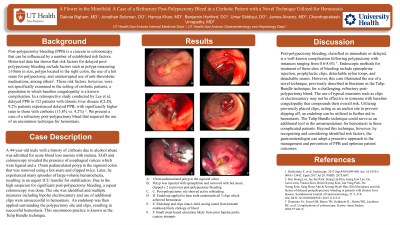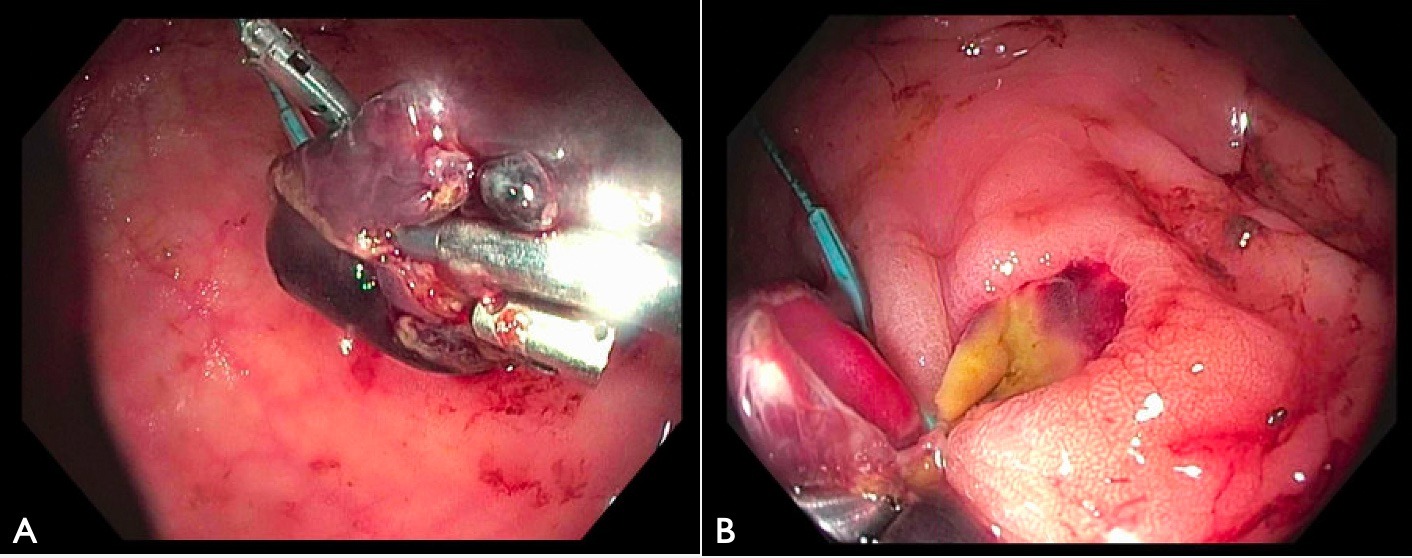Sunday Poster Session
Category: Interventional Endoscopy
P0889 - A Flower in the Minefield: A Case of a Refractory Post-Polypectomy Bleed in a Cirrhotic Patient With a Novel Technique Utilized for Hemostasis
Sunday, October 22, 2023
3:30 PM - 7:00 PM PT
Location: Exhibit Hall

Has Audio

Dakota Bigham, MD
University of Texas Health Science Center-San Antonio
San Antonio, TX
Presenting Author(s)
Dakota Bigham, MD1, James Alvarez, MD1, Chandraprakash Umapathy, MD, MS2
1University of Texas Health Science Center-San Antonio, San Antonio, TX; 2University of Texas Health Science Center at San Antonio, San Antonio, TX
Introduction: Post-polypectomy bleeding (PPB) is a complication of colonoscopy that can be influenced by several established risk factors. These risk factors, however, were not specifically examined in the setting of cirrhotic patients, a population in which baseline coagulopathy can increase the risk of bleeding. We present a case of a refractory post-polypectomy bleeding that required the use of an uncommon technique for hemostasis.
Case Description/Methods: A 44-year-old male with alcoholic cirrhosis was admitted for melena and acute blood loss anemia. Esophagogastroduodenoscopy (EGD) and colonoscopy revealed the presence of esophageal varices, which were ligated, and a 15 mm pedunculated polyp in the sigmoid colon that was resected using a hot snare ,followed by prophylactic clipping. Later, he experienced the onset of large-volume hematochezia, requiring transfer to the Intensive Care Unit (ICU) for stabilization. Due to the high suspicion for significant post-polypectomy bleeding, a repeat colonoscopy was performed, and the bleeding was localized to the polypectomy site. Multiple measures, including bipolar electrocautery and use of additional clips were unsuccessful. An Endoloop was then applied surrounding the polypectomy site and all clips, which successfully achieved hemostasis.
Discussion: This was a case that illustrated the use of a novel technique, previously described in the literature as the Tulip Bundle technique, for refractory post-polypectomy bleed. The use of typical measures such as clips or electrocautery may not be effective in individuals with baseline coagulopathy that compounds their overall risk. The Tulip Bundle technique could serve as an additional tool in the armamentarium for hemostasis. Beyond this technique, however, by recognizing and considering identified risk factors, the gastroenterologist can adopt a proactive approach in the management and prevention of PPB and optimize patient outcomes. Known preventive measures include prophylactic clips, detachable nylon loops, and detachable snares.

Disclosures:
Dakota Bigham, MD1, James Alvarez, MD1, Chandraprakash Umapathy, MD, MS2. P0889 - A Flower in the Minefield: A Case of a Refractory Post-Polypectomy Bleed in a Cirrhotic Patient With a Novel Technique Utilized for Hemostasis, ACG 2023 Annual Scientific Meeting Abstracts. Vancouver, BC, Canada: American College of Gastroenterology.
1University of Texas Health Science Center-San Antonio, San Antonio, TX; 2University of Texas Health Science Center at San Antonio, San Antonio, TX
Introduction: Post-polypectomy bleeding (PPB) is a complication of colonoscopy that can be influenced by several established risk factors. These risk factors, however, were not specifically examined in the setting of cirrhotic patients, a population in which baseline coagulopathy can increase the risk of bleeding. We present a case of a refractory post-polypectomy bleeding that required the use of an uncommon technique for hemostasis.
Case Description/Methods: A 44-year-old male with alcoholic cirrhosis was admitted for melena and acute blood loss anemia. Esophagogastroduodenoscopy (EGD) and colonoscopy revealed the presence of esophageal varices, which were ligated, and a 15 mm pedunculated polyp in the sigmoid colon that was resected using a hot snare ,followed by prophylactic clipping. Later, he experienced the onset of large-volume hematochezia, requiring transfer to the Intensive Care Unit (ICU) for stabilization. Due to the high suspicion for significant post-polypectomy bleeding, a repeat colonoscopy was performed, and the bleeding was localized to the polypectomy site. Multiple measures, including bipolar electrocautery and use of additional clips were unsuccessful. An Endoloop was then applied surrounding the polypectomy site and all clips, which successfully achieved hemostasis.
Discussion: This was a case that illustrated the use of a novel technique, previously described in the literature as the Tulip Bundle technique, for refractory post-polypectomy bleed. The use of typical measures such as clips or electrocautery may not be effective in individuals with baseline coagulopathy that compounds their overall risk. The Tulip Bundle technique could serve as an additional tool in the armamentarium for hemostasis. Beyond this technique, however, by recognizing and considering identified risk factors, the gastroenterologist can adopt a proactive approach in the management and prevention of PPB and optimize patient outcomes. Known preventive measures include prophylactic clips, detachable nylon loops, and detachable snares.

Figure: A. Endoloop and clips intact; mild oozing noted from beneath endoloop likely etiology of bleed
B. Small clean-based ulceration likely from prior bipolar probe cautery attempts
B. Small clean-based ulceration likely from prior bipolar probe cautery attempts
Disclosures:
Dakota Bigham indicated no relevant financial relationships.
James Alvarez indicated no relevant financial relationships.
Chandraprakash Umapathy indicated no relevant financial relationships.
Dakota Bigham, MD1, James Alvarez, MD1, Chandraprakash Umapathy, MD, MS2. P0889 - A Flower in the Minefield: A Case of a Refractory Post-Polypectomy Bleed in a Cirrhotic Patient With a Novel Technique Utilized for Hemostasis, ACG 2023 Annual Scientific Meeting Abstracts. Vancouver, BC, Canada: American College of Gastroenterology.

